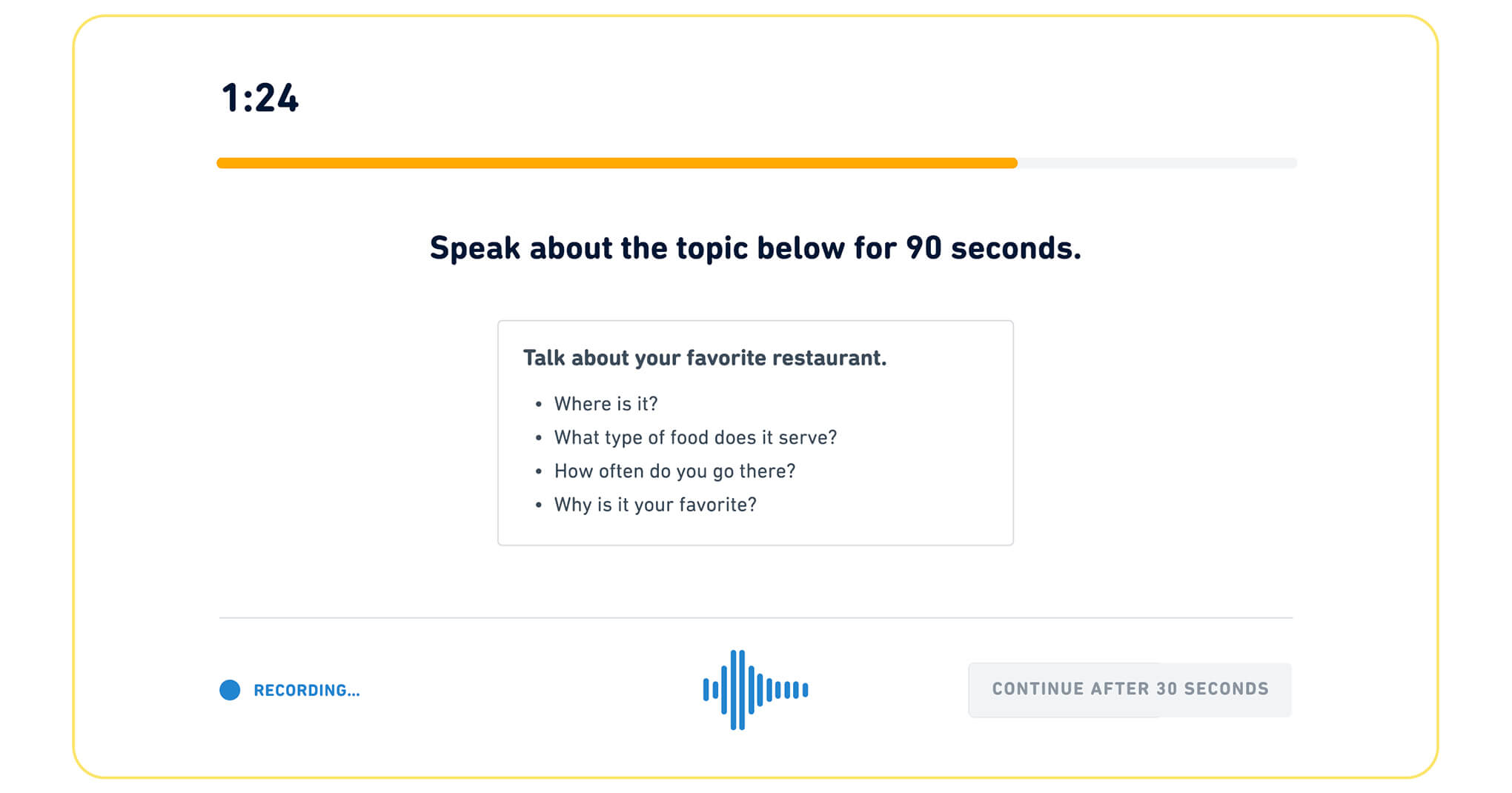Introduction
On the Duolingo English Test, there will be four questions that require you to speak for an extended length of time.
- Read, Then Speak
- Listen, Then Speak
- Speak About the Photo
- Speaking Sample
The first speaking question you will see on test day will most likely be the Read, Then Speak question.
And this question type makes a lot of test-takers nervous.
The reason?
You are required to speak for up to 90 seconds to a random question. It doesn’t sound like a long time, but 90 seconds feels like forever on test day.
How can you speak for so long to some random question?
That is what we are going to learn together.
By the end of this short article, you will know about the possible Read, Then Speak questions, the grading criteria, how to structure your response, and how to practice at home.
Or if you are just ready to practice right away, check out this free practice question.


Over 100 Free DET Practice Questions
Here’s what you will learn:
Read, Then Speak - Everything You Need to Know
You will have 20 seconds to prepare your response and you must speak for between 30 to 90 seconds. The Read, Then Speak question type will contribute to your Conversation and Production score (Speaking)
Details:
Speaking Time
You will have 20 seconds to prepare. After that, you need to speak for a minimum of 30 seconds and a maximum of 90 seconds. Aim for a response closer to the 90-second mark for a higher score.
Question Frequency
Expect only 1 Read, Then Speak question on test day, typically appearing towards the end.
Speak Clearly
Be sure to speak in a loud, clear, and confident voice. If the computer can not hear your recording, you will not earn a high score.
Only One Chance
You can only record your response once so be sure to stay on topic and thoroughly answer the question.
Answer Every Part
Each question usually has multiple parts for the Read, Then Speak question type, so be sure to answer all of the questions included in the prompt.
Read, Then Speak - Question Types
- Describe – Past Experience (Past Tense): These prompts ask you to recount a personal experience related to a specific topic. Use past tense verbs to narrate the events.
- Typical Topics: Health and wellness, group work vs. individual work, travel experiences, recent books or movies, challenges you’ve faced, and school experiences.
- What was it?
- Who did you give it to?
- How did it make you feel?
- Why did you give this particular gift to this person?
- Describe – General Topic (Present Tense): These prompts ask you to describe a general topic, providing details and information. Use present tense verbs to convey factual information.
- Typical Topics: Countries or places, customs or cultures, hobbies or sports, famous people, educational systems, current events.
- What is the country?
- Where is it located?
- Why do you think this country is special?
Read, Then Speak - Grading Criteria
- Accurate Grammar: Use correct grammar and sentence structure in your response. An easy way to do this well is to stick to the simple present or simple past tense as much as possible. Use other verb tenses and grammatical forms if you feel comfortable doing so.
- Complex Grammar: If you use a bunch of simple sentences like, “One country I want to describe is Japan. Japan is in Asia. Japan is an interesting place. Japan… Japan… Japan,” you will not perform well. Vary your grammar with phrases like “while” and “which.” They will force you to utter sentences that are a bit longer and more complex.
- High-level Vocabulary: Do not try to use long and difficult words you do not fully understand like “disestablishmentarianism.” It will sound awkward. Just try not to repeat the same words and phrases too often.
- A Wide Range of Vocabulary: As I just mentioned, avoid repeating the same words or phrases. One easy way to do this is to include a personal example in your response, it will force you to tell a story with different subjects, items, and actions.
- Task Relevance: Read carefully and be sure to answer each part of the question. The prompt will remain on the screen while you are speaking.
- Fluency: Speak smoothly and naturally. Try to avoid awkward pauses and vocal fillers like “um” or “uh.”
- Pronunciation and Speech Music: Avoid words you have trouble pronouncing. Also, while speaking, imagine you are having a casual conversation with a friend. It will help you speak in a natural manner.
Don’t forget, the grading criteria are laid out in the DET Test Readiness Guide, which you can download for free here.
Read, Then Speak - Quick Tips
- Templates Are Overrated: Some test takers try to follow a rigid structure, which can be helpful but can also lead to stress. Start by answering all of the questions presented in order and check if your response sounds natural.
- Target Speaking Time: Aim to speak for at least 45 seconds to earn a better score. Longer responses typically score higher since they include more vocabulary and grammar.
- Clear and Natural Delivery: Speak in the same way you would while having a natural conversation with a friend. Nervous students tend to whisper or sound robotic. Take a deep breath and answer the question in a loud, clear, and comfortable voice.
- Answer Each Question: I said it before but I will say it again, be sure to answer all of the questions presented. This should be simple since the prompt will remain on the screen while you speak.
- Target Word Count: Aim for a word count between 100-200 words (closer to 200) to ensure a high score.
Read, Then Speak - How to Practice
- Practice Without a Timer: Watching a timer count down makes many test-takers nervous. Practice without a timer first. Focus on feeling comfortable since that will help improve your delivery.
- Record and Check: Everyone hates the sound of their voice, but, unfortunately, recording and listening to your response is one of the best ways to improve. Do it.
- Seek Feedback: Asking a teacher to assess your speaking is one of the most valuable investments you can make. Experienced teachers can tell you exactly what you need to do to improve.
- Practice with a Variety of Prompts: Use the free Read, then Speak questions on the Duolingo website and also on TST Prep to gain exposure to a variety of topics.
- Youglish: Type in any word or phrase and you can find dozens of examples of native speakers pronouncing them.
- Free4Talk: You can practice speaking English with other like-minded language learners for free.
- Study with AI Tools: Explore AI-powered language learning tools like ChatGPT or language learning apps to improve vocabulary and practice speaking.


Over 100 Free DET Practice Questions
Conclusion
Now you know A LOT more about the Read, Then Speak questions. Be sure to speak for at least 45 seconds, have a clear and confident delivery, and answer each question asked. Imagine you are having a conversation with a friend and include personal examples to help you vary your vocabulary and grammar structures.
Keep these tips and ideas in mind when you practice and when you take the exam and you will do great!
Did that help?
Do you have any more tips for this question type?
Share in the comments below and help us all improve.









